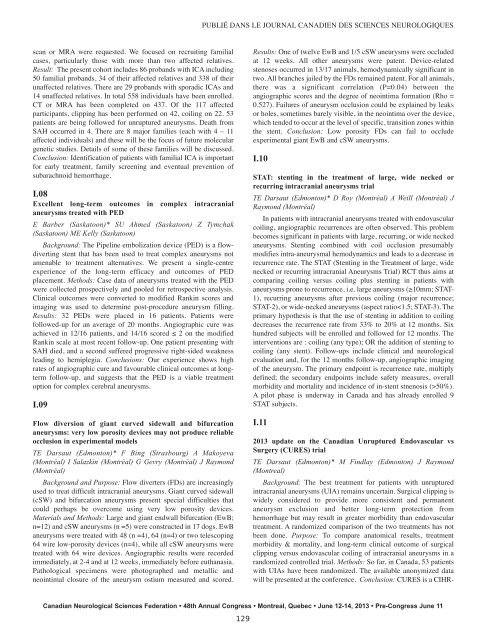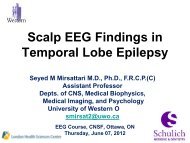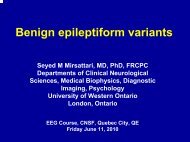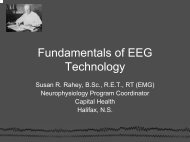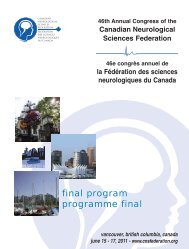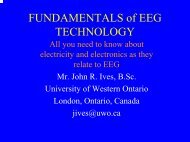Download Program - Canadian Neurological Sciences Federation
Download Program - Canadian Neurological Sciences Federation
Download Program - Canadian Neurological Sciences Federation
You also want an ePaper? Increase the reach of your titles
YUMPU automatically turns print PDFs into web optimized ePapers that Google loves.
PUBLIé DANS LE JOURNAL CANADIEN DES SCIENCES NEUROLOGIqUES<br />
2013 update on the <strong>Canadian</strong> Unruptured Endovascular vs<br />
Surgery (CURES) trial<br />
TE Darsaut (Edmonton)* M Findlay (Edmonton) J Raymond<br />
(Montreal)<br />
Background: The best treatment for patients with unruptured<br />
intracranial aneurysms (UIA) remains uncertain. Surgical clipping is<br />
widely considered to provide more consistent and permanent<br />
aneurysm exclusion and better long-term protection from<br />
hemorrhage but may result in greater morbidity than endovascular<br />
treatment. A randomized comparison of the two treatments has not<br />
been done. Purpose: To compare anatomical results, treatment<br />
morbidity & mortality, and long-term clinical outcome of surgical<br />
clipping versus endovascular coiling of intracranial aneurysms in a<br />
randomized controlled trial. Methods: So far, in Canada, 53 patients<br />
with UIAs have been randomized. The available anonymized data<br />
will be presented at the conference. Conclusion: CURES is a CIHRscan<br />
or MRA were requested. We focused on recruiting familial<br />
cases, particularly those with more than two affected relatives.<br />
Result: The present cohort includes 86 probands with ICA including<br />
50 familial probands, 34 of their affected relatives and 338 of their<br />
unaffected relatives. There are 29 probands with sporadic ICAs and<br />
14 unaffected relatives. In total 558 individuals have been enrolled.<br />
CT or MRA has been completed on 437. Of the 117 affected<br />
participants, clipping has been performed on 42, coiling on 22. 53<br />
patients are being followed for unruptured aneurysms. Death from<br />
SAH occurred in 4. There are 8 major families (each with 4 – 11<br />
affected individuals) and these will be the focus of future molecular<br />
genetic studies. Details of some of these families will be discussed.<br />
Conclusion: Identification of patients with familial ICA is important<br />
for early treatment, family screening and eventual prevention of<br />
subarachnoid hemorrhage.<br />
I.08<br />
Excellent long-term outcomes in complex intracranial<br />
aneurysms treated with PED<br />
E Barber (Saskatoon)* SU Ahmed (Saskatoon) Z Tymchak<br />
(Saskatoon) ME Kelly (Saskatoon)<br />
Background: The Pipeline embolization device (PED) is a flowdiverting<br />
stent that has been used to treat complex aneurysms not<br />
amenable to treatment alternatives. We present a single-centre<br />
experience of the long-term efficacy and outcomes of PED<br />
placement. Methods: Case data of aneurysms treated with the PED<br />
were collected prospectively and pooled for retrospective analysis.<br />
Clinical outcomes were converted to modified Rankin scores and<br />
imaging was used to determine post-procedure aneurysm filling.<br />
Results: 32 PEDs were placed in 16 patients. Patients were<br />
followed-up for an average of 20 months. Angiographic cure was<br />
achieved in 12/16 patients, and 14/16 scored ≤ 2 on the modified<br />
Rankin scale at most recent follow-up. One patient presenting with<br />
SAH died, and a second suffered progressive right-sided weakness<br />
leading to hemiplegia. Conclusions: Our experience shows high<br />
rates of angiographic cure and favourable clinical outcomes at longterm<br />
follow-up, and suggests that the PED is a viable treatment<br />
option for complex cerebral aneurysms.<br />
I.09<br />
Flow diversion of giant curved sidewall and bifurcation<br />
aneurysms: very low porosity devices may not produce reliable<br />
occlusion in experimental models<br />
TE Darsaut (Edmonton)* F Bing (Strasbourg) A Makoyeva<br />
(Montréal) I Salazkin (Montréal) G Gevry (Montréal) J Raymond<br />
(Montréal)<br />
Background and Purpose: Flow diverters (FDs) are increasingly<br />
used to treat difficult intracranial aneurysms. Giant curved sidewall<br />
(cSW) and bifurcation aneurysms present special difficulties that<br />
could perhaps be overcome using very low porosity devices.<br />
Materials and Methods: Large and giant endwall bifurcation (EwB;<br />
n=12) and cSW aneurysms (n =5) were constructed in 17 dogs. EwB<br />
aneurysms were treated with 48 (n =4), 64 (n=4) or two telescoping<br />
64 wire low-porosity devices (n=4), while all cSW aneurysms were<br />
treated with 64 wire devices. Angiographic results were recorded<br />
immediately, at 2-4 and at 12 weeks, immediately before euthanasia.<br />
Pathological specimens were photographed and metallic and<br />
neointimal closure of the aneurysm ostium measured and scored.<br />
Results: One of twelve EwB and 1/5 cSW aneurysms were occluded<br />
at 12 weeks. All other aneurysms were patent. Device-related<br />
stenoses occurred in 13/17 animals, hemodynamically significant in<br />
two. All branches jailed by the FDs remained patent. For all animals,<br />
there was a significant correlation (P=0.04) between the<br />
angiographic scores and the degree of neointima formation (Rho =<br />
0.527). Failures of aneurysm occlusion could be explained by leaks<br />
or holes, sometimes barely visible, in the neointima over the device,<br />
which tended to occur at the level of specific, transition zones within<br />
the stent. Conclusion: Low porosity FDs can fail to occlude<br />
experimental giant EwB and cSW aneurysms.<br />
I.10<br />
STAT: stenting in the treatment of large, wide necked or<br />
recurring intracranial aneurysms trial<br />
TE Darsaut (Edmonton)* D Roy (Montréal) A Weill (Montréal) J<br />
Raymond (Montréal)<br />
In patients with intracranial aneurysms treated with endovascular<br />
coiling, angiographic recurrences are often observed. This problem<br />
becomes significant in patients with large, recurring, or wide necked<br />
aneurysms. Stenting combined with coil occlusion presumably<br />
modifies intra-aneurysmal hemodynamics and leads to a decrease in<br />
recurrence rate. The STAT (Stenting in the Treatment of large, wide<br />
necked or recurring intracranial Aneurysms Trial) RCT thus aims at<br />
comparing coiling versus coiling plus stenting in patients with<br />
aneurysms prone to recurrence, i.e. large aneurysms (≥10mm; STAT-<br />
1), recurring aneurysms after previous coiling (major recurrence;<br />
STAT-2), or wide-necked aneurysms (aspect ratio50%).<br />
A pilot phase is underway in Canada and has already enrolled 9<br />
STAT subjects.<br />
I.11<br />
<strong>Canadian</strong> <strong>Neurological</strong> <strong>Sciences</strong> <strong>Federation</strong> • 48th Annual Congress • Montreal, Quebec • June 12-14, 2013 • Pre-Congress June 11<br />
129


